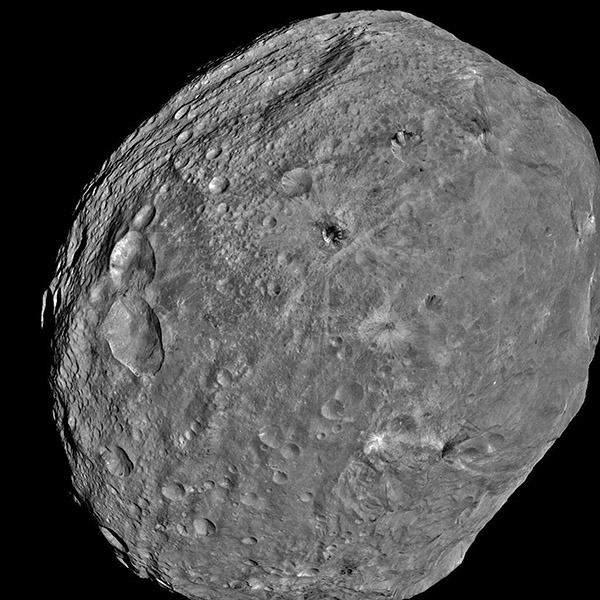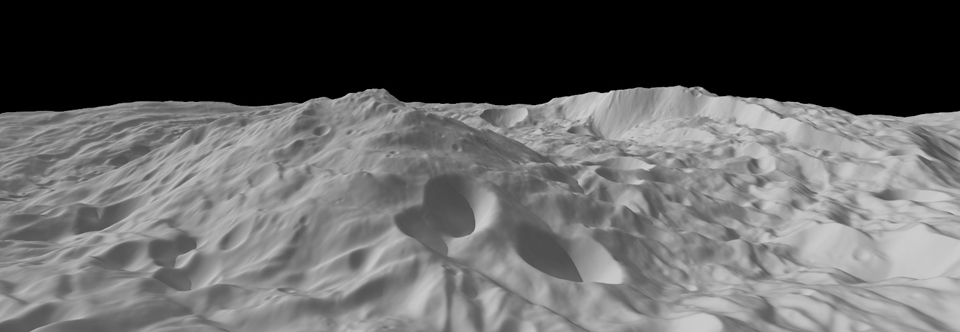
On September 27th, 2007, NASA’s Dawn spacecraft left Earth and began a multi-year journey to two of the largest objects in the solar system’s main asteroid belt. The first stop on its interplanetary roadtrip was the asteroid Vesta. Dawn reached the Arizona-sized chunk of primordial rock in 2011, providing scientists with the first close-up view of the asteroid’s ancient surface.
A leftover remnant from the formation of the solar system over four billion years ago, Vesta may be similar in composition to the larger bits of celestial debris that originally came together to form the inner planets. Scientists studying our planet’s origins hope that Vesta will reveal clues about our past that have long been erased by plate tectonics and weathering on Earth.
“Studying Vesta is like going back to the beginning of the solar system,” said Jennifer Scully, a third-year UCLA graduate student working on the Dawn mission. “It is kind of like a fossil of the sort of bodies that were around that combined to make the Earth,” she said. Scully, the lead mapper for two large areas on Vesta, makes geological maps of the asteroid’s surface in order to interpret the history of different features and formations.
What she has found so far has been surprising. “We discovered a lot of things that were unexpected at Vesta,” she said. Grayscale and color images taken by Dawn’s framing camera show a remarkable range of shades on the surface of Vesta, featuring both very bright and very dark material. “It’s very colorful,” said Scully. “We think the dark material is residue from meteorites called carbonaceous chondrites that have hit the surface.”
Data from Dawn’s instruments including the camera’s seven color filters, a spectrometer, and a neutron detector help scientists characterize surface deposits and divide Vesta into areas depending on age, composition, and morphology. But sometimes this close-up view of Vesta raises more questions than answers.
“We found both straight and sinuous gully features and I’m investigating what sort of flow(s) formed them,” said Scully. Whether or not some of the gully features could have been carved by molten rock is under investigation. “The team has not found any definitive features of volcanism,” Scully said. “There could have been activity early on, but the evidence has been wiped clean by billions of years of impacts.”
Evidence of many of these impacts is preserved on Vesta’s surface in the form of craters. These craters range in size from being so small that Dawn’s camera can barely resolve them to being so large that they have diameters nearly as big as Vesta. The two largest impact basins on the asteroid, named Veneneia and Rheasilvia, are found in Vesta’s southern hemisphere. Scully is one of many Dawn scientists who are working to connect these impact basins with structures in Vesta’s northern hemisphere. “The current understanding is that each of these large impacts sent shock waves through Vesta, which formed large-scale ridges and depressions on the opposite side,” said Scully.
The Dawn spacecraft does not only examine the surface of an asteroid, it can also give scientists clues about its internal structure. “From the way the gravity pulls on the spacecraft you can tell about the internal layers and the size of the core,” said Scully. From examining how Vesta’s gravitational field tugs on Dawn, scientists believe that Vesta has a distinct crust, mantle, and core like Earth.
The same is likely not true for the asteroid Ceres, Vesta’s younger cousin and the next and final stop for the Dawn spacecraft. After remaining in orbit around Vesta for one year, the Dawn spacecraft took its leave in September of 2012 to begin a three-year journey to Texas-sized Ceres, the largest object in the main asteroid belt located between Mars and Jupiter. Unlike Vesta, scientists think Ceres may harbor large amounts of water ice under its surface. Because Ceres is wetter than Vesta, it will present a whole new set of questions. Scully looks forward to directly comparing the data collected from the two asteroids when the spacecraft arrives at Ceres in 2015.
For Scully, the decision to come to UCLA and work with Professor Christopher Russell was a “no brainer.” “Getting to work on an actual active mission is pretty awesome. You get to meet a lot of people and really see how a team works,” she said. In addition to her work on the geology of Vesta, Scully helped create an online system called Asteroid Mappers where citizen scientists can identify features on Vesta using real data collected by Dawn.
Watch a video profile of Jennifer Scully here. Learn more about her research here.
Follow Iplex
